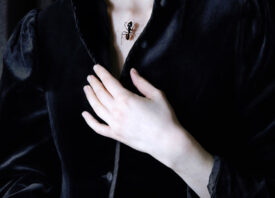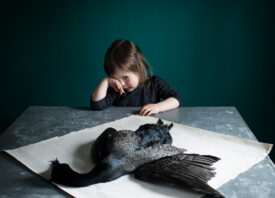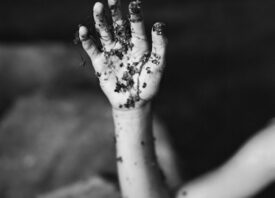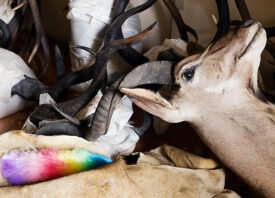Search this site
Honoring Animals Who Have Died, in Images

© Emma Kisiel
Sylvilagus Floridanus 6, 2012
Inkjet print

© Julia Schlosser
Syringes used in euthanasia procedure (These are the needles that were used to euthanize my cat Sebastian on 2/27/2017. Sebastian suffered from multiple health issues for many years, and finally when he had lost so much weight and stopped eating, I decided to have him euthanized. He was 17.), 2017
Archival digital pigment print from scan, 20 x 26.67 in.

Emma Kisiel
Toxostoma Rufum 2, 2012
Inkjet print
In one of her classic children’s books, the author Margaret Wise Brown tells the story of a group of kids who find a dead bird. They try to find a heartbeat, but they are unsuccessful. “The bird was dead when the children found it,” she writes. “The children were very sorry the bird was dead and could never fly again.” Like the characters in the book, most of us learn about mortality when we’re young through the death of an animal. It’s sad and frightening, and it usually marks us in some essential way.
Remembering Animals: Rituals, Artifacts & Narratives in Contemporary Art, curated by the artist and art historian Julia Schlosser and currently on view at the Main Art Gallery at California State University, Northridge in California, is an examination of the deaths of animals. The animals presented in the show range from the intimately known to the anonymous. The artists honor beloved household animals, but they also pay heed to the many overlooked creatures bred for meat, entertainment, experimentation, and other exploitations. The only qualification for remembrance is that they are gone. Some died of illness, and others were killed, intentionally or accidentally, by humans.
The photographer Emma Kisiel finds and holds the dead bodies of rabbits and birds, inspired in part by Cher Ami, the hero homing pigeon who died as a result of his wounds during the First World War. The artists Steve Baker and Craig Stecy, who contend with “roadkill” in different ways (both photographically), are included in the exhibition, as is Hyewon Keum, who photographs funeral rites for companion animals in the US, Japan, and Korea.
Kathy High photographs the lives and deaths of transgenic rats and collaborates with her dog Lily in a video exploration of Derrida. Schlosser scans the body of her late rabbit Claire, as well as the euthanasia needles used for her cat Sebastian. Curtis Bartone makes etchings to remind us of the loss of farm and laboratory animals. Linda Brant and Sarah Perry incorporate the literal remains (rather than the images) of deceased animals into their work.
As part of the exhibition, Schlosser and Joe Bautista have created anilum: A Digital Candle-lighting Memorial Experience, where online visitors from around the world are welcome to submit photographs and stories of animals who have died. Here, you can find memories of love, triumph, heartbreak, and remorse involving creatures of all kinds. Some of them are named; others do not. There’s an ode to the shelter animals euthanized due to overpopulation, and there’s one for a stray dog whose rescuer had to give her up. A few animals have been entered more than once. There’s a place for animals who lived, suffered, and died in captivity: Tilly the orca, Harambe the gorilla.
Grief isn’t unique to humans. Elephants stand over each other’s dead bodies. Horses do too, sometimes for hours and hours. Dolphins carry the bodies of their deceased offspring. Some animals won’t eat following the loss of a loved one. Animals cherish one another and value their own lives, even when humans do not. In an inescapable sense, mortality and mourning connect us to other animals. Regardless of the ways in which we communicate and live, we all die, watch others die, and experience the pain that follows.
Schlosser admits that spending time with some of these works might be emotionally difficult, but in the end, that uncomfortable prick of grief and regret eases and gives way to recognition. None of the animals featured in the exhibition or posted in anilum will ever know we’ve seen them and remembered them–they’re already lost to us–but we will acknowledge that they lived nonetheless. It might not be enough, but it’s something to hold onto. “The children were very sorry the bird was dead and could never fly again,” Brown writes in The Dead Bird, “But they were glad they had found it, because now they could dig a grave in the woods and bury it. They could have a funeral and sing to it the way grown-up people did when someone died.”
See Remembering Animals: Rituals, Artifacts & Narratives in Contemporary Art at CSUN Art Galleries through March 17th, 2018. Take a quick look at the Remembering Animals exhibition catalog below, and get your own copy here.

© Steve Baker
Scapeland XIX, 2014
Constructed photograph, 16 x 48 in.

Curtis Bartone
Pestilence (from “Plague Poem” suite), 2016
Etching (two plates), 12 x 16 in

© Linda Brant
Bullet hole, sheep skull, 2015
Photograph, 22 x 22 in.

Kathy High
HLA B27, 2008
Color photograph, 42 x16 in.

Kathy High
Lily Does Derrida: A Dog’s Video Essay, 2010-12
Video still, duration: 29:30 min.

© Hyewon Keum
Cloud Shadow Spirit, R23, 2013
digital pigment print, 31.5 x 47.2 in.

© Hyewon Keum
Still Life, Muffin, 2014
digital pigment print, 32.7 x 39.4 in.

© Emma Kisiel
Columba Livia, 2012
Inkjet print

Sarah Perry
Skin Deep, 2009
Taxidermied rat, Visible Man educational toy, steel, linoleum, plastic, acrylic paint, sealants, mixed media, 17 x 7 x 9.5 in.
No creatures were harmed for this sculpture and it is in complete compliance with the California Fish and Game Dept.
Photo by Gene Ogami

© Julia Schlosser
Claire’s body, 7/5/2011, 1:58 p.m., from the series Claire Last Days, 2011
Archival digital pigment print from scan, 20 x 26.67 in.

Julia Schlosser
Sebastian and flames, 2/27/2017, 10:31 a.m.
(Towards the end of the cremation process, the technician opened the oven and broke up Sebastian’s bones so the process could be completed.), 2017
Archival digital pigment print, 7 x 10 in., framed size 14 x 11 in.

© C. R. Stecyk III
Postcard (front)
215 Juanita Way
San Francisco, CA, 1982
6 1/2 x 4 ¼ in.

C. R. Stecyk III
Postcard (front)
Route 66
Amarillo, TX
1981
6 1/2 x 4 ¼ in.

© Schlosser / Bautista
anilum, 2018, detail, user submission, interactive digital experience incorporating motion controller, video and user generated imagery, 204 x 144 in.

© Schlosser / Bautista
anilum, 2018, detail, user submission, interactive digital experience incorporating motion controller, video and user generated imagery, 204 x 144 in.

© Schlosser / Bautista
anilum, 2018, detail, user submission, interactive digital experience incorporating motion controller, video and user generated imagery, 204 x 144 in.

© Schlosser / Bautista
anilum, 2018, detail, user submission, interactive digital experience incorporating motion controller, video and user generated imagery, 204 x 144 in.

© Schlosser / Bautista
anilum, 2018, detail, user submission, interactive digital experience incorporating motion controller, video and user generated imagery, 204 x 144 in.



